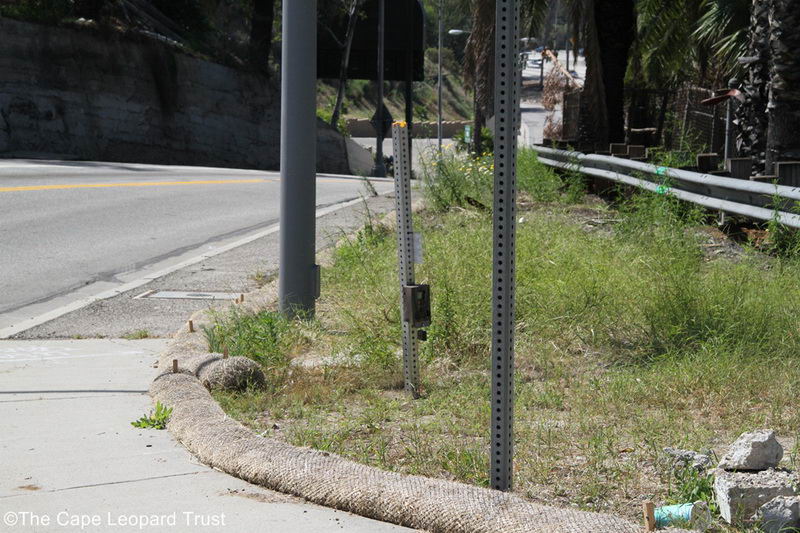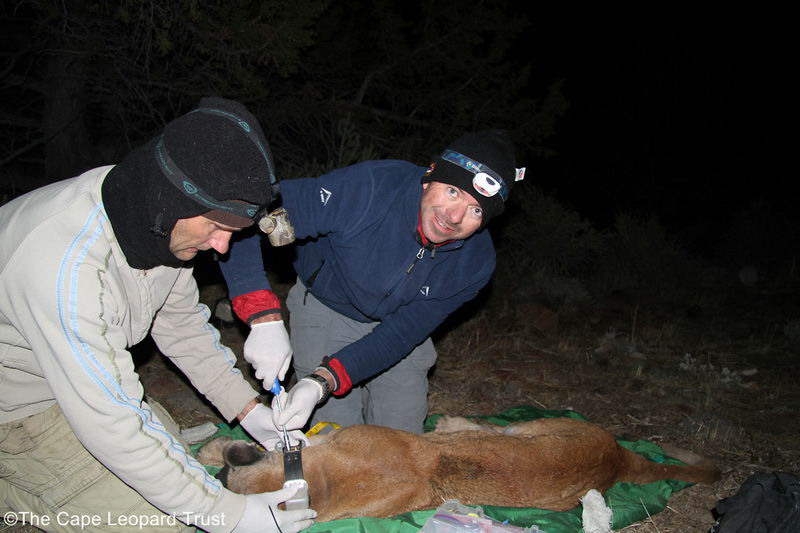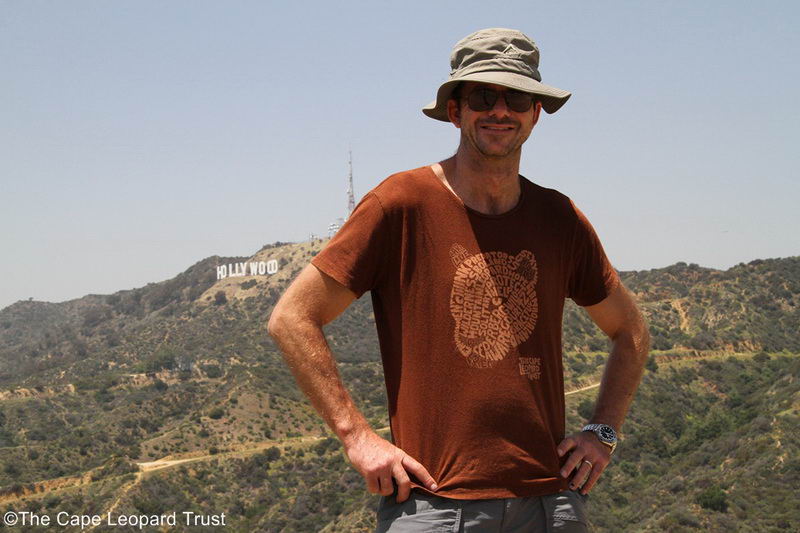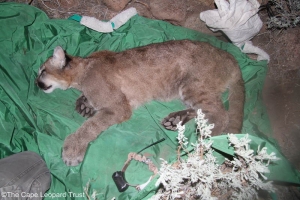Quinton Martins recently spent a few weeks in the USA visiting research projects and giving talks. Here he tells all on returning from what sounded like a fascinating trip.
Born in the USA – 6 month old mountain lion cub trapped and collared for research. Photo: Q. Martins
“ In May, I embarked on a research trip to the USA in an attempt to gain a better understanding of leopard and caracal behaviour and ecology through work conducted on analogous species in comparable circumstances. Mountain lions Puma concolor, also known as cougars or pumas would be the closest equivalent to our leopards, while bobcats Felis rufus most similar to our caracal. The circumstances that interested me were that of (i) the urban environment; and (ii) the arid and rugged mountain environment. Beyond that, many questions relating to, amongst others, human-predator conflict and the role of predators in ecosystems.
California
What better place to understand how large predators interact with humans, inhabiting human-fragmented and impacted landscapes, than the greater city of Los Angeles, California. Here, in the Santa Monica Mountains, north of LA, mountain lions, bobcats and coyotes coexist with humans in an extraordinary set of circumstances, rubbing shoulders with the wealthy in Malibu, or heading downtown to Griffith Park. Natural areas are bisected by large multi-lane highways inhibiting free movement of a many mammal species, and even some small bird species. These natural refugia can clearly support a plethora of mammal species, including large carnivores and persist despite fragmentation due to housing estates, golf courses or malls. Mountain lions have large ranges and occur in low densities. Consequently, they also have the biggest dispersal and movement issues.
I was invited to work with US National Park Services (NPS) field biologists on their mountain lion project they have had running for over a decade. One person I spent most of my time with was Jeff Sikich, an experienced researcher and expert carnivore trapper. This was a great experience and I was pleased to see Jeff using foot snares for captures, a preferred research tool for most large carnivore researchers. His aim was to capture and collar lions, understand their movements and find ways of creating corridors allowing movement between natural areas. Currently only 1 adult male and a couple of females utilize the Santa Monica’s west of the 101 highway – an area of about 700 km2. Younger dispersing lions, however, have a significantly low survival rate – they are either killed by vehicles trying to cross the highways, or killed by resident adults intolerant of their presence. Camera traps on possible cross-over points are one way to monitor the effectiveness of corridors.

Camera Trap keeping an eye out for animal movement over a bridge in the Hollywood district Photo: Q. Martins
To capture the contrast between these wild and iconic cats and the urban complex in which they are forced to live, I was fortunate to have spent some time with award winning National Geographic photographer Steve Winter, of snow leopard photo fame. His mission was to capture a mountain lion photograph in LA visibly showing the juxtaposition between these large wild carnivores and the city. This was right down my alley having spent years in the fields scouting good camera-trap locations. Being in the field with such a photographic guru was just incredible. Trying to capture a lion photograph where right behind me stood the “Hollywood” sign was bizarre.
Bobcats too are being studied in Santa Monica, and I managed to track 7 bobcats in a residential suburb of LA. Of great concern to these and other carnivores, is poisoning due to human use of rodenticides. Potent anticoagulants such as Heparin have been recorded in up to 90% of carnivores captured, resulting in significant mortality rates. How does this compare to what we have in Cape Town with our resident caracals or even our leopards bordering towns or agricultural areas? We hope to know soon. Inspired by this trip, the CLT aim to tackle this issue.

Bobcat – slightly smaller than our caracal Photo: Q. Martins
Having had the opportunity of presenting at the University of California Los Angeles (UCLA), NPS in the Santa Monica’s and Sequoia National Park, I met with several experts in this field. I also found the quality of research being conducted here of the very highest standard. Overall, I was very impressed and learnt a great deal. I believe that in general, we can learn a lot from the predator-related research that has come out of the USA. For more on carnivore work in the Santa Monica’s see: www.UrbanCarnivores.com
Nevada
Next on my trip was visiting Alyson Andreasen, PhD mountain lion researcher with the University of Reno. Working in the Sierra-Nevada Mountains on the border of Nevada and California, Alyson has done some unbelievable work. She has collared over 40 mountain lions, documented over 1000 GPS clusters looking for kills, hiked, horse-backed, ridden on quad bikes and generally slaved away over the past few years to collect these data in an amazing landscape of dry and rugged mountains. Her husband, Jake, has assisted her with captures and, being a film-maker, has also documented her work on film.
My time with the two of them was jam-packed with action. We were caught in snow storm, worked through the night during captures and talked about our work every spare moment. We captured 3 lions (1 adult female and 2 cubs) and located some of their kills during my visit. In the Virginia and Pinyon-Juniper ranges, they are, believe it or not, mostly wild horses (usually <1yr old, but still!). In the Carson Mountains surrounding Lake Tahoe, lions are feeding mostly on mule deer. These differences in prey use are very interesting and are being explored by Alyson. All these cats also have massive home ranges similar to our Karoo leopards – about 700 km2 for a male and 200 – 300 km2 for females.

In my element – collaring of a 101 lb female mountain lion with Jake & Alyson photo: A. Andreasen
Arizona
Despite being a rather big detour, I arranged a visit and talk at the Senora Desert Museum in Tucson, Arizona. This was the final leg of my journey and one well worth it. The open air museum with its collection of local fauna and flora is an impressive display highlighting a unique and diverse ecosystem. Professionally run with 125 permanent staff and over 500 volunteers, this centre displays the wonders of this amazing landscape in an informative and inspiring way. The conservation value of this centre hardly ends in public awareness and education. Behind the scenes, rare and endangered species are bred and re-released back into their natural habitats. Animals are cared for in the best possible way. I was particularly interested in the vast snake collection. Eighteen species of rattlesnakes! It was amazing to see such a phenomenal collection of this much maligned reptile.
Acknowledgements
I wish to thank the following people for their support and wonderful hospitality. Every day was an exceptional experience for me. I was also honoured to be the first visiting researcher at the La Kretz Institute Research Facility. Lastly, LA would not have been the same without having Linton Pope (www.redleopardtea.com) invite me to see Roger Waters perform The Wall live at the Coliseum!

Thank you to all
Alyson Andreasen & Jake Willers
Carl Goldfischer
Craig Ivanyi
Jon & Melanie Keeley
Zarra Macdonald
Jack Majszak and Stephanie Davis
Linton Pope
Dr Seth Riley
Laurel Klein Serieys
Prof Brad Shaffer
Jeff and Sarah Sikich
Steve Winter
















